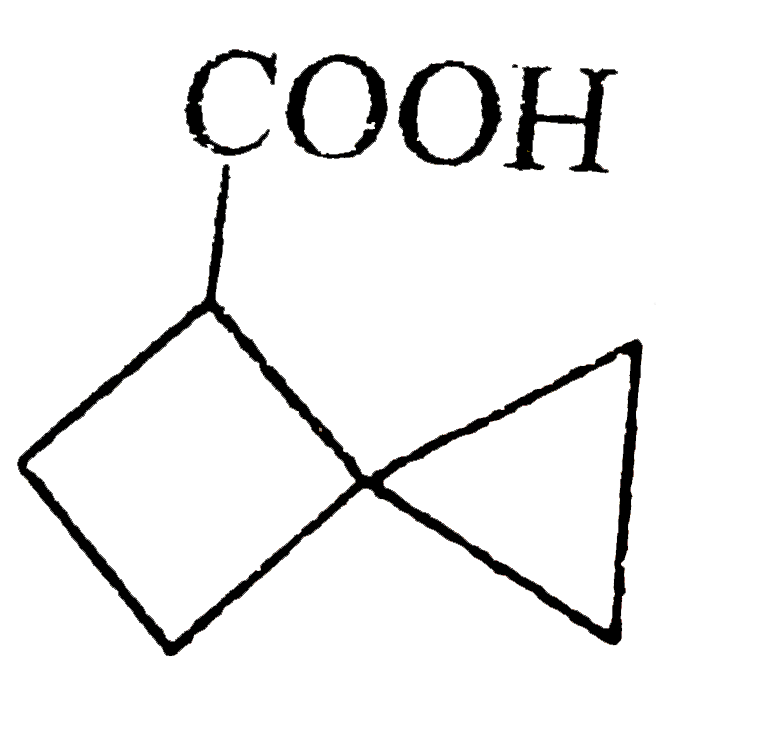If the organic compound contains more than two similar terminal groups and all of them are directly attached to the principal chain, then none of them forms a part of the principal chain. Special suffixes are used to name these.
Carbon atoms of these terminal groups are not counted in the principal chain. If any one of these terminal groups is not directly attached to the parent chain and forms the part of side chain, then the longest chain is selected containing two such similar groups at its two ends. The groups present in the side chain are treated as substituents and are indicated by suitable prefixes.
Indicate whether the following IUPAC name are true (a) or false (b).
The correct Answer is:a
Topper's Solved these Questions
- CLASSIFICATION AND NOMENCLATURE OF ORGANIC COMPOUNDS BOOK - OP TANDONCHAPTER - CLASSIFICATION AND NOMENCLATURE OF ORGANIC COMPOUNDS EXERCISE - INTEGER
2 Videos
- CLASSIFICATION AND NOMENCLATURE OF ORGANIC COMPOUNDS BOOK - OP TANDONCHAPTER - CLASSIFICATION AND NOMENCLATURE OF ORGANIC COMPOUNDS EXERCISE - ASSERTION REASON
4 Videos
- Chemical Thermodynamics and ThermochemistryBOOK - OP TANDONCHAPTER - Chemical Thermodynamics and ThermochemistryEXERCISE - Self Assessment (Integer type).
3 Videos
- COORDINATION COMPOUNDSBOOK - OP TANDONCHAPTER - COORDINATION COMPOUNDSEXERCISE - SBJECTIVE TYPE
96 Videos
Similar Questions
Comprehension # 1
If the organic compound contains more than two similar terminal groups and all of them are directly attached to the principal chain, then none of them forms a part of the principal chain. Special suffixes are used to name these :-
Functional groupSuffix−CONH2Carboxamide−CNCarbonitrile−CHOCarbaldehyde−COOHCarboxylic acid
Carbon atoms of these terminal groups are not counted in the principal chain. If any one of these terminal groups is not directly attached to the paraent chain and forms the part of side chain, then the longest chain is selected containing two such similar groups at its two ends. The groups present in the side chain are treated as substituents and are indicated by suitable prefixes.
Indicate whether the following IUPAC names are true (a) or false (b)
_E01_044_Q01.png)
View SolutionIf the organic compound contains more than two similar terminal groups and all of them are directly attached to the principal chain, then none of them forms a part of the principal chain. Special suffixes are used to name these.
Functional groupSuffix−CONH2Carboxamide−CNCarbonitrile−CHOCarbaldehyde−COOHCarboxylic acid
Carbon atoms of these terminal groups are not counted in the principal chain. If any one of these terminal groups is not directly attached to the parent chain and forms the part of side chain, then the longest chain is selected containing two such similar groups at its two ends. The groups present in the side chain are treated as substituents and are indicated by suitable prefixes.
Indicate whether the following IUPAC name are true (a) or false (b).
Compound IUPAC Name CONH2 ∣H2NOC−CH2−CH−CH2−CONH2 Propane-1,2,3-tricarboxamide True (a) False (b)
View SolutionIf the organic compound contains more than two similar terminal groups and all of them are directly attached to the principal chain, then none of them forms a part of the principal chain. Special suffixes are used to name these.
Functional groupSuffix−CONH2Carboxamide−CNCarbonitrile−CHOCarbaldehyde−COOHCarboxylic acid
Carbon atoms of these terminal groups are not counted in the principal chain. If any one of these terminal groups is not directly attached to the parent chain and forms the part of side chain, then the longest chain is selected containing two such similar groups at its two ends. The groups present in the side chain are treated as substituents and are indicated by suitable prefixes.
Indicate whether the following IUPAC name are true (a) or false (b).
Compound IUPAC Name CH2−COOH ∣HOOC−CH2−CH−CH2−COOH 3-(carboxymethyl)pentane-1,5-dioic acid True (a) False (b)
View SolutionIf the organic compound contains more than two similar terminal groups and all of them are directly attached to the principal chain, then none of them forms a part of the principal chain. Special suffixes are used to name these.
Functional groupSuffix−CONH2Carboxamide−CNCarbonitrile−CHOCarbaldehyde−COOHCarboxylic acid
Carbon atoms of these terminal groups are not counted in the principal chain. If any one of these terminal groups is not directly attached to the parent chain and forms the part of side chain, then the longest chain is selected containing two such similar groups at its two ends. The groups present in the side chain are treated as substituents and are indicated by suitable prefixes.
Indicate whether the following IUPAC name are true (a) or false (b).
Compound IUPAC Name CH2CHO ∣OHC−CH2−CH−CH2−CHO 3-(formylmethyl)pentane-1,5-dial True (a) False (b)
View SolutionIf the organic compound contains more than two similar terminal groups and all of them are directly attached to the principal chain, then none of them forms a part of the principal chain. Special suffixes are used to name these.
Functional groupSuffix−CONH2Carboxamide−CNCarbonitrile−CHOCarbaldehyde−COOHCarboxylic acid
Carbon atoms of these terminal groups are not counted in the principal chain. If any one of these terminal groups is not directly attached to the parent chain and forms the part of side chain, then the longest chain is selected containing two such similar groups at its two ends. The groups present in the side chain are treated as substituents and are indicated by suitable prefixes.
Indicate whether the following IUPAC name are true (a) or false (b).
Compound IUPAC Name CN ∣NC−CH2−CH−CH2−CN 3-cyanopentane-1,5-dinitrile True (a) False (b)
View SolutionOrganic compounds containing an amino group and carboxyl group on the same carbon atom are called
View SolutionWhat suffixes or prefixes are used for the following functional groups ?

View SolutionThe suffix in ethanol is used to Define Which functional Group
View SolutionWrite the position of principal functional groups ?

View SolutionThe principal functional group is indicated by adding a specific suffix to the word root.
View Solution
